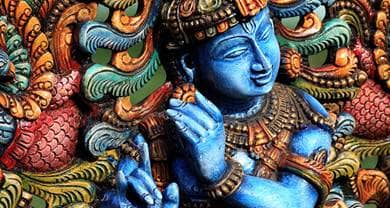- Trending:
- Easter
- |
- Lent
- |
- Forgiveness
- |
- Resurrection
- |
- Joy
- |
- Feminism

RELIGION LIBRARY
Hinduism
Sacred Space
Hindu gods and goddesses are understood to be active forces in the world. Through a variety of rituals, they are made present to their devotees. Usually, although not exclusively, they are made present in temples. Temples are sacred because they are where the gods and goddesses live, and where humans have access to them. Temples are also where many, although by no means all, Hindu rituals are performed.
 Hindu temples are broadly called mandira, or mandir, a Sanskrit word that means, essentially, "house." A temple in the Hindu view is thus fundamentally the earthly abode of a god or goddess; it is sacred space because the deity is present there.
Hindu temples are broadly called mandira, or mandir, a Sanskrit word that means, essentially, "house." A temple in the Hindu view is thus fundamentally the earthly abode of a god or goddess; it is sacred space because the deity is present there.
There are thousands of Hindu temples in India and elsewhere, temples associated with the major "high" gods and goddesses, but also local deities. Each temple is different, its style and structure dictated by the region in which it is located, when it was constructed, and the deity to whom it is associated.  Hindu temples have been built for some 2,000 years. That said, there are some general commonalities.
Hindu temples have been built for some 2,000 years. That said, there are some general commonalities.
At the center of the temple complex is the main structure that houses the main image, or murti—the physical image of the deity, which, unlike in many other religions, is not merely a symbolic representation. The murti is the deity; it is considered to be the living god, and is treated as such. It is often bathed, fed, and directly addressed by the god's devotees. This main image is typically located within the garbha griha (literally "womb chamber"), what in English might be called the "sanctum sanctorum." This inner sanctum is typically crowned with a tower, or shikhara. In some temples , these towers are tall, magnificent structures, while in others they are far more basic.
, these towers are tall, magnificent structures, while in others they are far more basic.
Around the central shrine area are often many other smaller shrines, often with images of gods and goddesses associated with the main deity of the temple, as well as meeting and worship halls, classrooms, administrative offices, etc. Usually the temple complex is surrounded by a wall, which is entered through a main gate. Often this gate is part of what can be a very elaborate tower or spire, called a gopuram or gopura, a sometimes very elaborate structure that is covered with sculptural images of gods, goddesses, and other divine figures. In southern India, in particular, major temples often feature elaborately decorated towering gopurams that soar over both the temple itself and the city in which it is located.
goddesses, and other divine figures. In southern India, in particular, major temples often feature elaborately decorated towering gopurams that soar over both the temple itself and the city in which it is located.
A single deity, or multiple deities in many temples, is understood to be fully present in the temple. Devotees come to the temple and make ritual offerings to the deity, and take darshan, literally the "sight" of the deity.  Hinduism, however, also holds that the gods and goddesses are simultaneously present in many, potentially infinite, different places. Thus Shiva can be fully and completely present in a temple (or many temples) in northern India and fully and completely present in a temple (or many temples) in southern India and in any other part of the world.
Hinduism, however, also holds that the gods and goddesses are simultaneously present in many, potentially infinite, different places. Thus Shiva can be fully and completely present in a temple (or many temples) in northern India and fully and completely present in a temple (or many temples) in southern India and in any other part of the world.
 There are many other sorts of sacred space in India, many of them significant pilgrimage destinations. These include rivers, which are understood to be goddesses. Of particular importance in this regard are special "crossings," or tirthas, places where the gods and goddesses "cross" into the human world.
There are many other sorts of sacred space in India, many of them significant pilgrimage destinations. These include rivers, which are understood to be goddesses. Of particular importance in this regard are special "crossings," or tirthas, places where the gods and goddesses "cross" into the human world.
Video: Early Morning on the River Ganga
| There are, classically, seven particularly sacred places in India: | |
| 1. Benares, or Kashi, the eternal city of Shiva. |  |
| 2. Allahabad, where the Ganges, Yamuna, and mythical Sarasvati rivers merge. |  |
| 3. Mathura, the birthplace of Krishna. |  |
| 4. Hardwar, where the Ganges enters the plains of India. |  |
| 5. Ayodhya, the earthly birthplace of the god Rama. | |
| 6. Dvaraka, Krishna's capital. | |
| 7. Kanchipuram, the site of several ancient temples in southern India. |  |
This list of sacred places is by no means exhaustive. There are thousands of minor and dozens of major tirthas throughout the Indian subcontinent. Indeed, in an important sense the entirety of India is understood to be a sacred space.
 Mountains are also often regarded as sacred places; like the tirthas, they are the special, natural abode of the gods and goddesses. For instance, Mount Kailash, in the Tibetan Himalayas, is understood by many Hindus (and Buddhists as well) to be the special abode of Shiva and his consort, Parvati. Likewise, Mata Vaishno Devi Temple, in the Indian Himalayas (in the modern state of Jammu Kashmir), is the sacred abode and, according to some myths, the birthplace of the goddess Vaishno Devi.
Mountains are also often regarded as sacred places; like the tirthas, they are the special, natural abode of the gods and goddesses. For instance, Mount Kailash, in the Tibetan Himalayas, is understood by many Hindus (and Buddhists as well) to be the special abode of Shiva and his consort, Parvati. Likewise, Mata Vaishno Devi Temple, in the Indian Himalayas (in the modern state of Jammu Kashmir), is the sacred abode and, according to some myths, the birthplace of the goddess Vaishno Devi.  Tens of thousands of pilgrims make the arduous trek to the temple each year, a pilgrimage that ends at the natural cave where the goddess' murti resides. Pilgrims crowd into the cramped cave to take darshan of the goddess and to make offerings to her.
Tens of thousands of pilgrims make the arduous trek to the temple each year, a pilgrimage that ends at the natural cave where the goddess' murti resides. Pilgrims crowd into the cramped cave to take darshan of the goddess and to make offerings to her.
The sheer number and variety of sacred spaces and places in the Hindu world is staggering. In an important sense, the whole of the Indian subcontinent is sacred space, the abode of the gods and goddesses. This, in part, explains why Hinduism has tended not to spread outside of India.

Study Questions:
1. What are mandir, and why are they sacred?
2. How does the Hindu concept of darshan differ from other religious traditions’ use of imagery?
3. Describe the major components of a Hindu temple.
4. How has the conception of sacred space limited the spread of Hinduism?










